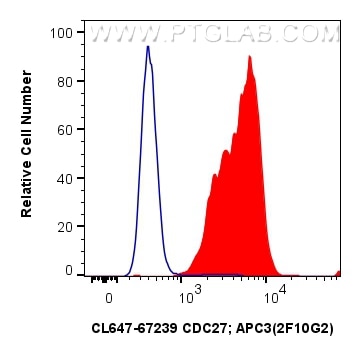Anticorps Monoclonal anti-CDC27; APC3
CDC27; APC3 Monoclonal Antibody for FC (Intra)
Hôte / Isotype
Mouse / IgG2b
Réactivité testée
Humain, rat, souris
Applications
FC (Intra)
Conjugaison
CoraLite® Plus 647 Fluorescent Dye
CloneNo.
2F10G2
N° de cat : CL647-67239
Synonymes
Galerie de données de validation
Applications testées
| Résultats positifs en FC (Intra) | cellules K-562 |
| Résultats positifs en cytométrie | cellules K-562 |
Dilution recommandée
| Application | Dilution |
|---|---|
| Flow Cytometry (FC) (INTRA) | FC (INTRA) : 0.40 ug per 10^6 cells in a 100 µl suspension |
| Flow Cytometry (FC) | FC : 0.40 ug per 10^6 cells in a 100 µl suspension |
| It is recommended that this reagent should be titrated in each testing system to obtain optimal results. | |
| Sample-dependent, check data in validation data gallery | |
Informations sur le produit
CL647-67239 cible CDC27; APC3 dans les applications de FC (Intra) et montre une réactivité avec des échantillons Humain, rat, souris
| Réactivité | Humain, rat, souris |
| Hôte / Isotype | Mouse / IgG2b |
| Clonalité | Monoclonal |
| Type | Anticorps |
| Immunogène | CDC27; APC3 Protéine recombinante Ag25588 |
| Nom complet | cell division cycle 27 homolog (S. cerevisiae) |
| Masse moléculaire calculée | 92 kDa |
| Poids moléculaire observé | 90-100 kDa |
| Numéro d’acquisition GenBank | BC011656 |
| Symbole du gène | CDC27 |
| Identification du gène (NCBI) | 996 |
| Conjugaison | CoraLite® Plus 647 Fluorescent Dye |
| Excitation/Emission maxima wavelengths | 654 nm / 674 nm |
| Forme | Liquide |
| Méthode de purification | Purification par protéine A |
| Tampon de stockage | PBS with 50% glycerol, 0.05% Proclin300, 0.5% BSA |
| Conditions de stockage | Stocker à -20 °C. Éviter toute exposition à la lumière. Stable pendant un an après l'expédition. L'aliquotage n'est pas nécessaire pour le stockage à -20oC Les 20ul contiennent 0,1% de BSA. |
Informations générales
CDC27/APC3 is a component of the anaphase-promoting complex (APC/cyclosome), which is composed of eight subunits and highly conserved in eukaryotic cells. The APC/cyclosome complex acts as a cell cycle-regulated E3 ubiquitin ligase which mediates ubiquitination and subsequent degradation of target proteins, and lead to the progression control through mitosis and the G1 phase of the cell cycle.


